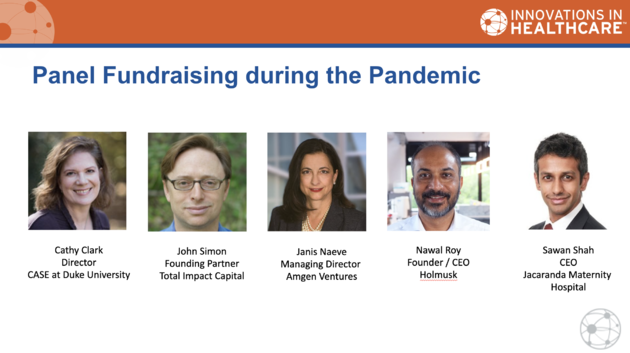May 27, 2020 LAN Biweekly Call Summary
Click here to view the recording.
This week’s webinar featured a panel titled “Fundraising During the Pandemic.”
Panelists included:
-
Cathy Clark: Director of the Center for Advancement of Social Entrepreneurship at Duke University, which works with social enterprises around the world to scale their impact
-
John Simon: Managing Partner of Total Impact Capital, an impact investing firm focused on health, water, food, renewable energy
-
Janis Naeve: Managing Director of Amgen Ventures, an arm of the largest biotech company that offers seed funding for early stage funding
-
Nawal Roy: Founder and CEO of Holmusk, a real world evidence platform in behavioral health
-
Sawan Shah: CEO of Jacaranda Maternity Hospital
-
For investors, how has the landscape changed due to COVID-19, has the total transaction volume sped up or slowed down, how have the investment criterion shifted? (7:15)
Simon, from Total Impact Capital, focused on how COVID-19 presents both a challenge and an opportunity, as economic activity in all sectors has seen a sudden decline. The health sector bears a disproportionate burden of this effect, as many individuals who would have previously gone to health facilities now avoid them for fear of infection, and yet, they are essential infrastructure in the face of this pandemic. From an investor point of view, this challenge makes justifying the profitability of health sector investment difficult. Luckily, funding has come available to rise up to the challenge, and the sector is an extremely competitive marketplace. Naeva, representing Amgen Ventures, spoke broadly about the life sciences venture capital market as well as Amgen Ventures’ particular situation. In regards to the market, although investment and deployment has slowed, she is optimistic that companies still have enough capital to deploy if needed. The slowdown is largely due to the lockdown that has delayed due diligence processes, which Naeva believes will pick back up when restrictions are lifted. On the other hand, Amgen is still very actively investing. Though not directly on COVID-19 matters, it is catering towards tangential health areas affected by the virus, such as its impacts on kidneys, the heart, and inflammation.
-
For innovators, how has the fundraising landscape changed due to COVID-19, what challenges have you faced and how have you had to shift your approach? (15:12)
Holmusk and Jacaranda Maternity Hospital recently closed deals with investors amidst the advent of COVID-19. Unfortunately, Holmusk experienced difficulties with their investors because of the pandemic, while Jacaranda’s were able to offer assistance, such as extending timelines. Shah highlighted how Jacaranda learned it ‘pays to really know who your investors are,’ as the pandemic truly showed that their investors were committed to their social impact mission. Both entrepreneurs agreed that for companies starting the fundraising process now will face significant challenges.
-
What resources are available to identify capital and what resources are there for funding, for those who are starting in this environment? (22:25)
CASE at Duke University has joined a COVID-19 alliance with the World Economic Forum and the Schwab Foundation to form covidcap.com/. The website is a database of funding sources for all social entrepreneurs, and now comprises over 800 opportunities totalling over $1.1 trillion of general relief (resources not conditioned on an organization’s impact, but rather to help them stay afloat). It has attracted over 25,000 visitors, 55% of whom come from outside the US, and has gained traction in over 110 countries total. At 28:32, Clark walks through the website and several of its important pages: a search for cash resources, a form for funders to add their own resources, and a help platform with guides, videos, and information on best practices specific to fundraising during COVID-19.
-
What is the most important thing an innovator can do to attract funding in this environment? (36:08)
Panelists emphasized an innovator’s willingness to be open and flexible during the pandemic, recognizing that unfortunately, now is not the time to be insistent on a specific valuation. At the same time, they advised innovators to stay true to their company’s mission and focus on whether it aligns with the funder in question. Roy specifically noted the importance of having open communication on a deal’s expected closing timeline, while Naeve highlighted the power of groups and finding the right syndicate of investors. Lastly, Clark advised innovators to clearly illustrate to investors how the pandemic has impacted their business model and how they plan to adjust, in addition to exploring other forms of capital than equity.
-
Has investing undergone a fundamental and permanent shift as a result of the pandemic? (47:12)
Like all other industries, many meetings that previously occurred in person will now shift online. Some sectors within the health industry, such as mental and behavioral health, will benefit from this change because they have proven how telemedicine and still be effective during the crisis. Similarly, resilient business models that can operate during this time, such as digital loans that reduce costs and cover cash flow shortfalls and aspects of the due diligence process that can be automated, will thrive.

